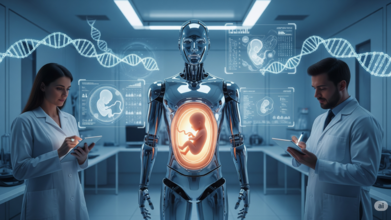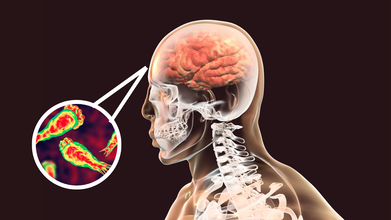- Health Conditions A-Z
- Health & Wellness
- Nutrition
- Fitness
- Health News
- Ayurveda
- Videos
- Medicine A-Z
- Parenting
- Web Stories
World’s First Pregnancy Robots: Will Women Soon Be Able to Use Surrogate Robots?

(Credit - Heathandme)
While technology has long assisted in the birthing process, researchers at Kaiwa Technology, China are now taking it a step further by creating artificial wombs that can be placed inside a robot. According to Dr Zhang Qifeng, who is leading the project, the technology for artificial wombs is already significantly advanced, and the team aims to demonstrate a working prototype as early as next year.
The robot is expected to ‘become’ pregnant and carry a baby to full term in an environment filled with artificial amniotic fluid, designed to mimic the natural conditions of a human womb. Although the exact process of fertilization has not yet been disclosed, the project is being described as a potential game-changer for people who cannot conceive naturally or are unable to carry a pregnancy to term.
Ethical Concerns And Unanswered Questions
As with any radical new technology, the robot womb comes with serious ethical and legal questions. How will the egg and sperm be fertilized? What does the birthing process look like? And who will be legally responsible for the baby? Dr Qifeng says discussions with Chinese officials are already underway to create new regulations for this emerging field.
One of the biggest draws as per the company is its cost. The estimated price of using the robot for surrogacy could be around $14,000, a fraction of the $100,000–$200,000 typically spent in the U.S. for human surrogacy.
New Era Of Reproduction Or Dystopian Step?
The news has sparked a heated debate. Supporters believe the technology could offer new hope to infertile couples and free women from the physical risks of pregnancy. Some even see it as a potential solution to China’s growing infertility crisis.
Critics believe that the biological and emotional complexity of human pregnancy cannot be replicated by a machine. Experts fear that growing a baby in a completely artificial environment could have unknown effects on the child’s health and well-being, and that removing the maternal bond from the process might lead to ethical dilemmas.
9-Year-Old Passes Away In Kerala Due To 'Brain Eating Amoeba' Infection: How To Spot The First Symptom?

(Credit - Canva)
Brain Eating Amoeba: A 9-year-old girl has fallen victim to a rare case of primary amoebic meningoencephalitis (PAM), popularly known as brain eating amoeba. Two more reports have been made including a three-month old baby, both of whom are fighting for their lives. Health officials from Kerala have reported no common factors among the three cases, explaining that they are unable to find how a three-month old got infected with the rare disease.
While they have speculated that the amoeba could’ve entered the body through the nose while bathing, however it is also found in dust and soil.
However, this is not the first time this disease was found in Kerala. There have been previous cases of the same, first being reported in 1971.
What Is Brain Eating Amoeba?
According to a 2024 article published in the Infectious Diseases Journal, the infection is caused by an amoeba called Naegleria fowleri, which lives in warm freshwater, such as lakes and rivers. It can enter the body through the nose, usually when people are swimming or using contaminated tap water. Once inside, it travels to the brain and causes severe damage, leading to a fast-acting and often fatal illness.
Though rare, the disease is extremely dangerous, with a survival rate of only about 3%. Most people who get infected die within five days of symptoms starting.
What Are The Symptoms of Brain Eating Amoeba?
According to the Centre of Disease Control and Prevention, early on, PAM symptoms can look like common meningitis:
- Fever
- Headache
- Stiff neck
- Nausea and vomiting
- Confusion
- Sensitivity to light
The disease progresses very quickly, with death often occurring within five days of the first symptoms. If you have these symptoms and have recently been in warm fresh water, you should see a doctor right away.
What Are The Risk Factors of Brain Eating Amoeba: How It Spreads
The amoeba infects people by entering the body through the nose, usually when someone swims or dives in warm freshwater. It can also happen when people use contaminated tap water to rinse their noses during religious practices or sinus irrigation. Once in the nose, the amoeba travels to the brain, where it causes severe swelling and destroys brain tissue.
You cannot get infected from drinking contaminated water, and the infection does not spread from person to person.
In the United States, most cases have been in southern states, but as the climate warms, the amoeba's range appears to be expanding northward.
The best way to prevent infection is to limit the amount of water that goes up your nose, especially when swimming or diving in warm freshwater.
Can It Be Treated?
Diagnosing PAM is difficult because it's so rare and the initial symptoms are not unique. While some drugs have been shown to work against the amoeba in a lab setting, their effectiveness is unclear since almost all cases have been fatal, even with treatment.
The 2024 review detailed how, while there is no guaranteed cure, doctors have used a few drugs to treat the small number of patients who have survived. A drug called miltefosine has shown some promise, and health officials in Kerala have already gotten a supply of it.
Scientists are also working on new treatments. Researchers have found promising new compounds, and even some natural substances, that could help fight the amoeba. The biggest challenge is finding a drug that can effectively reach the brain and work without causing major side effects.
How Are Health Officials Responding?
In Kerala, authorities are taking action to prevent more infections. They have issued public warnings to avoid swimming in stagnant or unchlorinated water and are encouraging the use of nose clips.
The article pointed our that this situation serves as a stark reminder that the world needs to prioritize research on this infection. As the climate changes and water temperatures rise, we need to understand how this might affect the spread of Naegleria fowleri. It is also crucial to improve water safety standards and educate the public to reduce the risk of exposure.
New ‘Off-the-Shelf’ Cancer Vaccine Shows Promising Results Against Deadly Pancreatic and Colorectal Cancers

(Credit - Canva)
One of the biggest medical breakthroughs has been cancer vaccines. Vaccines have helped us control and prevent infections like measles and chickenpox by recognizing harmful germs. On the other hand, cancer vaccines are designed to teach the immune system to identify and attack cancer cells. While some vaccines like for prostate and bladder cancer exist, more research needs to be done.
An exciting new development in cancer treatment is an experimental vaccine called ELI-002 2P. Unlike many other cancer vaccines that are custom-made for each patient's tumor, this one is "off-the-shelf." This means it can be mass-produced ahead of time, similar to a flu shot. This makes it potentially cheaper and faster to get than personalized vaccines. It shows encouraging results in helping prevent the return of pancreatic and colorectal cancer after a patient has had surgery.
Did The Vaccine Reduce Risk Of Cancer?
In a recent study published in the Nature Medicine, researchers gave the ELI-002 2P vaccine to 25 patients who had surgery for pancreatic or colorectal cancer. The results were promising patients who had a strong immune reaction to the vaccine went longer without their cancer returning and lived longer overall. They also found,
The median time for these patients to live without their cancer coming back was not even reached, while those with a weak response had a median of only about 3 months.
The overall survival for patients with a strong response was also much longer. The median survival was not reached for this group, but it was about 16 months for those with a weak response.
How Does the Cancer Vaccine Work
The ELI-002 2P vaccine works by teaching the body's immune system to recognize and attack specific cancer cells. Many pancreatic and colorectal cancers have a common genetic flaw in a gene called Kras.
This flaw causes the cancer cells to produce a slightly different version of a normal protein, which helps them grow out of control.
The study also showed that the vaccine not only taught the T-cells to attack the KRAS mutation but also triggered a process called "antigen spreading." This means the T-cells learned to recognize and fight other parts of the cancer cells, not just the one the vaccine targeted. This could lead to a broader and more powerful immune attack against the cancer.
While these early findings are very encouraging, it’s important to remember that this was a small, initial study. It was mainly designed to check if the vaccine was safe.
Experts say the next step is to conduct larger, more thorough trials to confirm the vaccine’s effectiveness. If successful, this off-the-shelf vaccine could become a valuable new tool, possibly combined with other treatments, to help fight cancers with the Kras gene flaw, including lung cancers.
Are There Side Effects of Cancer Vaccines?
While side-effects of this vaccine are yet to be mentioned, the American Cancer Society explained that cancer vaccines can have a rage of side-effects, which can vary from person to person depending on the type of vaccine. Many side effects are similar to what you might experience with other vaccines. These can include:
- Fever and chills
- Feeling tired (fatigue)
- Back and joint pain
- Nausea
- Headaches and dizziness
Some people may also have an infusion reaction, which can start suddenly, often within minutes or hours of receiving the treatment. These reactions might cause hives, severe itching, or more serious symptoms like trouble breathing, dizziness, or swelling of the lips and tongue. Your medical team will monitor you closely during treatment to manage any side effects right away. It is important to tell them about any new or unusual symptoms you experience.
Do Cancer Vaccines Work For Everyone?
Developing effective cancer vaccines is a complex challenge, which is why they don't work for every patient. Here are some of the main reasons:
Cancer cells are good at hiding
Cancer starts from your own healthy cells, so your immune system may not see them as a threat.
Cancer can weaken the immune system
Cancer cells actively suppress the immune system, making it harder for the body to fight back. Researchers often add special substances called adjuvants to vaccines to try to overcome this.
Larger tumors are harder to treat
Vaccines are most effective against very small amounts of cancer. This is why doctors often use vaccines alongside other treatments like surgery or chemotherapy.
A person's health affects the outcome
Older or sicker patients may have a weaker immune system, which can limit how well they respond to a vaccine. Some cancer treatments can also weaken the immune system, making the vaccine less effective.
The Endometriosis Battle Finally Comes To An End For Bindi Irwin, As She Undergoes Removal Of 51 Lesions, Cyst, And Appendix

Credits: Instagram and Canva
A Lifelong Battle With Endometriosis: In a heartfelt post, shared on Instagram, Bindi Irwin, daughter of 'Crocodile Hunter', Steve Irwin shared a health update where she wrote about her journey of battling with endometriosis. She wrote that after 13 years of "fighting for answers", she is finally healing.
Her post revealed that she had to undergo a total of removal of 41 endometriosis lesions, a chocolate cyst, her appendix, and repair of a hernia from childbirth.
She wrote: "51 endometriosis lesions, a cyst, and my appendix were all removed across two surgeries with @seckinmd. My hernia from giving birth that was unzipping – was taken care of. I can FINALLY say that I’m feeling better. Genuinely healing.”
ALSO READ: Why Do We Know So Little About Women's Health?
Battling Endometriosis
A conservationist herself, inspired by her father, shared that she felt ashamed as a teenager and young adult when she had to speak about the painful endometriosis symptoms she suffered. Her message was: No young woman should feel ashamed or alone with pain that is too often dismissed as "just part of being a woman".
She revealed her diagnosis in March 2023 on social media. Since then, she has highlighted about this condition, which affects millions worldwide. In her recovery and healing journey Dr Tamer Seckin, an endometriosis specialist played a prominent role, who removed the 51 lesions during two separate surgeries, reported Fox News.
What Is Endometriosis?
As per the World Health Organization (WHO), endometriosis affects roughly 10%, which estimates to 190 million of reproductive age women and girls globally. In US alone, it impacts around 9 million women.
The Journal of the American Medical Association notes that diagnosis is often delayed and it averages from 5 to 12 years after the onset of symptoms due to the stigma and misdiagnosis. Often dismissing the pain as part of being a girl.
WHO notes that endometriosis is a disease in which tissue similar to the lining of the uterus grows outside the uterus. It can cause severe pain in the pelvis and make it harder to get pregnant. The symptoms can start at menarche and last until menopause.
The cause of endometriosis is unknown, and the WHO also notes that there is no way to prevent it or no cure available. However, the symptoms can be treated with medicines, and in severe cases, surgery may be required.
In case of a chocolate cyst, which was the case with Bindi Irwin, the ovarian cyst is filled with a thick, dark, tar-like fluid, which resembles melted chocolate. This fluid is old blood and endometrial tissue, which has accumulated due to endometriosis.
What Are The Common Symptoms Of Endometriosis?
The common symptoms include:
- Severe pain in the pelvis, especially during menstruation
- Pain during sex
- Pain while using the bathroom
- Infertility issues
However, some people with endometriosis may not have any symptoms, however, they feel pain in the lower part of the belly, this is where pain is most noticeable.
Other symptoms include:
- Chronic pelvic pain
- Heavy bleeding during periods or between periods
- Trouble getting pregnant
- Nausea or bloating
- Fatigue
- Depression and anxiety
© 2024 Bennett, Coleman & Company Limited

